Doro Wat, a spicy Ethiopian Chicken Stew, is the Whole30-friendly comfort food you didn’t know you were missing! Simply ladle it over a bowl of cauliflower rice and you’ll fall in love with this fiery and rib-sticking healthy paleo chicken stew!

My inspiration for doro wat
Half a lifetime ago, I moved to Berkeley to attend college at the University of California—the birthplace of the countercultural revolution of the 1960s. I missed the action by a generation, but even as a wide-eyed freshman in the early nineties, I saw that the hippie flag still flew proudly. Aging Deadheads, Telegraph Avenue panhandlers, and hackey-sacking students alike reveled in the free-wheeling, anything-goes spirit of the community. For many of us who were living on our own for the first time, the intoxicating scent of freedom was in the air. (The air smelled like other things, too. We’re talking about Berkeley, after all.)
And why not? College is the time for experimentation. Some of my peers dabbled in mind-altering substances. Others explored alternative cultures, music, religions, sexual identities, and politics. Some took off all their clothes and strolled around campus naked.
Me? I was just there for the food.

My first taste of Ethiopian Food was in Berkeley
I’d never tried African cuisine before college. But not long after my newly-laminated student ID was in my wallet, one of my friends—an oh-so-worldly sophomore—invited me to dinner at The Blue Nile, a now defunct Berkeley institution (right next to People’s Park!) that served up rich, spicy Ethiopian stews and a sweet honey wine called tej.
There, in the restaurant’s dark and cozy dining room, I was introduced to a multitude of fragrant, assertively spiced dishes, from yebeg alicha (a hearty lamb stew) to siga tibs (beef sautéed with onions and tongue-tingling spices). These long-simmered stews came served atop a thin layer of soft injera bread. My friend showed me how to tear off bite-size pieces of the spongy, sour bread and use them to scoop the stews into my mouth. Everything was lip-smackingly delicious. I was hooked on Ethiopian food.
After that, I made a point of seeking out Ethiopian and Eritrean joints. Wherever I happened to be—from Berkeley to Harlem, San Francisco to Boston—I’d make sure I wound up seated before a wicker mesob, hungrily tearing into a platter of slow-cooked meats, vegetables, and lentils.

Henry never really understood my all-consuming obsession with this cuisine. The glacially slow service at my favorite Ethiopian restaurants in San Francisco always drove my impatient husband nuts. Still, when prodded, even he would admit that the dishes are worth the long wait.
Doro Wat
We both especially love doro wat—a slow-simmered spicy stew with fork-tender pieces of fall-off-the-bone chicken meat. Sadly, most Ethiopian restaurants only serve one or two chicken drumsticks with each order.
That’s one reason I decided to create my own Paleo-friendly doro wat recipe: I wanted to load up this fiery stew with as much chicken-y goodness as possible.
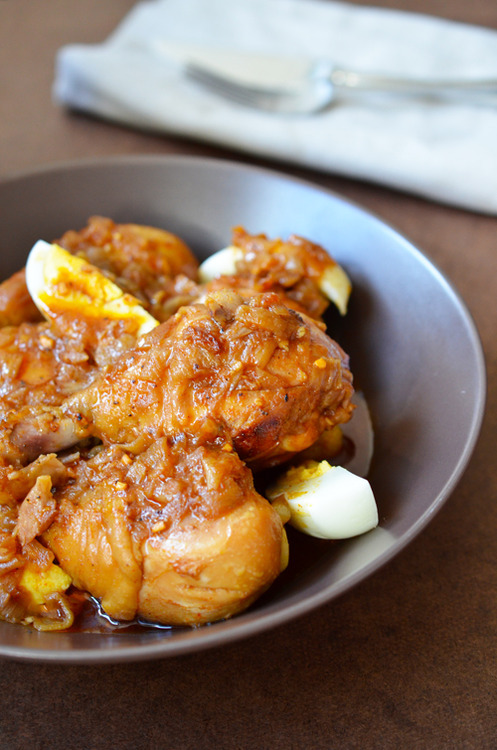
Doro wat is a traditional Ethiopian stew of chicken, eggs, and onions seasoned with a blend of ginger, garlic, and spices—and specifically, berbere seasoning. Berbere,which literally means “spicy” in Amharic, is a mouth-scorching mix of chili peppers, ginger, coriander, fenugreek, cardamom, cinnamon, and other spices, and it’s absolutely critical to this dish. Trust me: you can’t make a good, authentic doro wat without berbere.
Berbere Spice Blend
You can make a batch of berbere yourself (Saveur has a recipe here), or you can buy some from your friendly neighborhood spice purveyor.
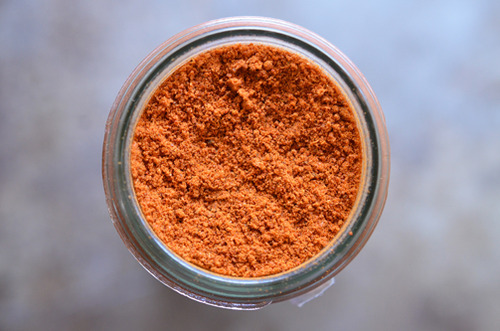
I was too lazy to whip up my own, but luckily, berbere is now available at Penzeys Spices!


Once you have some berbere at the ready, doro wat is a cinch to make. This long-simmered stew takes a bit of time and patience, but the steps are easy, and the recipe is foolproof.
Time to make Doro Wat!
Serves 6
Ingredients:
- 3 pounds chicken drumsticks (about 10 drumsticks), skin on or off
- Kosher salt
- ¼ cup ghee
- 2 medium red onions, thinly sliced
- 3 garlic cloves, finely minced
- 1 (1-inch) piece fresh ginger, peeled and finely grated (about
- 1 tablespoon)
- 1 tablespoon berbere seasoning (or more if you want your mouth to catch fire—we used 1½ tablespoons, but only because we’re masochists)
- ¼ teaspoon ground cardamom
- ¼ teaspoon freshly ground black pepper
- 2 cups chicken stock
- 4 hard-boiled eggs
- Juice from 1 lime (optional)
Method:
Thoroughly season the drumsticks with salt, and set aside.
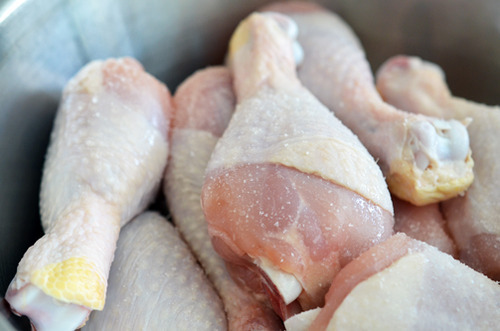
Heat the ghee in a large Dutch oven over medium heat. Add the sliced onions, and let them cook undisturbed for 1 to 2 minutes. Season liberally with salt, and gently turn over the pile of onions every 3 to 4 minutes to ensure even cooking.
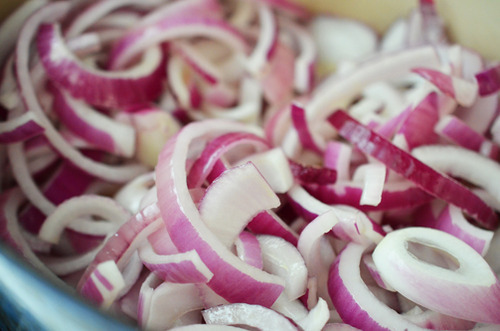
Once the onions have softened and significantly reduced in volume, about 15 minutes, turn the heat to medium-low.

Continue cooking, turning over the onion pile every 10 minutes or so, for 30 to 40 minutes or until golden brown and nicely caramelized.

The goal is to get the onions meltingly tender and sweet—and to do it right, this will take time. You know how some recipes call for cooking onions “5 minutes until caramelized”? That’s a low-down dirty lie. To properly caramelize onions, you’ll want to set aside the better part of an hour or more.

If you haven’t already minced your garlic and grated your ginger, do it already. By the way, you should always keep fresh ginger root in your freezer. When you’re ready to use it, you can simply break off a knob, peel off some skin, and grate it with a rasp grater like a Microplane. Plus, it lasts forever in the freezer.
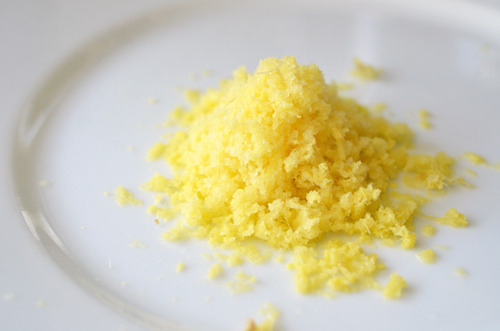
Stir the garlic and ginger into the caramelized onions, and cook until fragrant, about 30 seconds.

Add the berbere, cardamom, and black pepper and cook until fragrant.
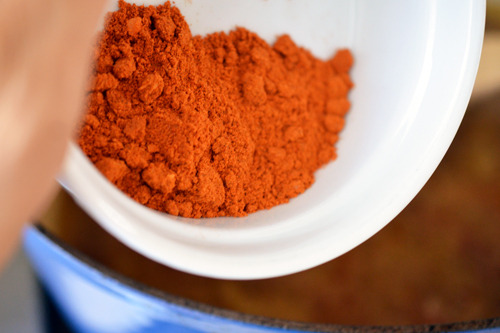
Then, pour in the chicken stock…
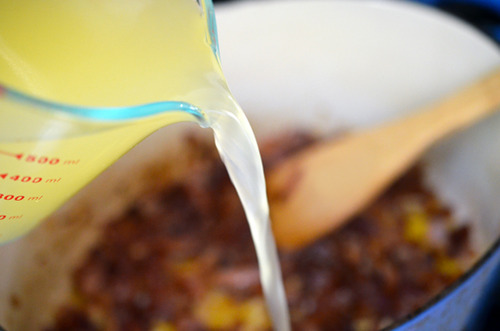
..and stir to mix well.

Nestle the drumsticks into the liquid, and bring the contents of the pot to a low simmer. Cover and cook, turning the drumsticks occasionally, for 45 minutes or until the meat is tender and cooked through.

In the meantime, make and peel 4 hard-boiled eggs.
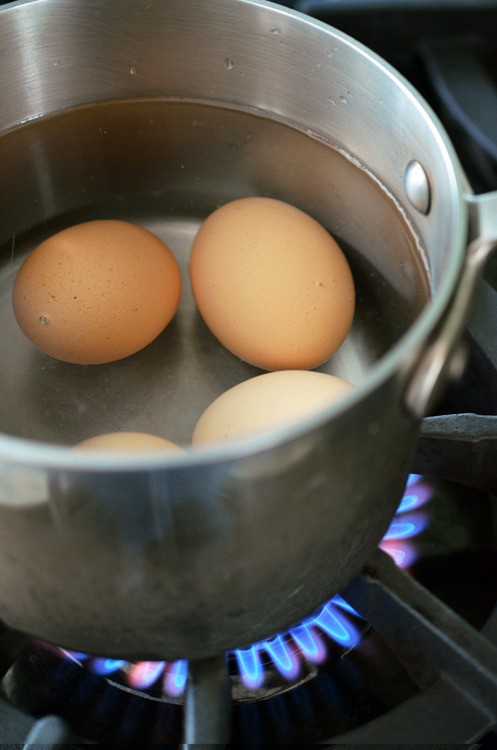
People: I hope you’re not just dumping a bunch of eggs into boiling water and(over)cooking them until stinky gray-green rings form around the dried, powdery yolks. That’s no way to treat your eggs.
Instead, read my instructions on how to make Perfect Hard-Boiled Eggs. Follow my tips, and your eggs will be a breeze to peel, and the yolks will be perfectly cooked.
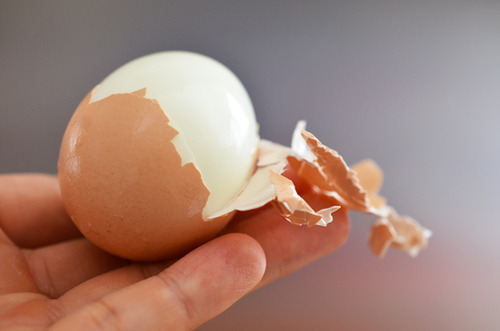
Plus, they won’t stink.
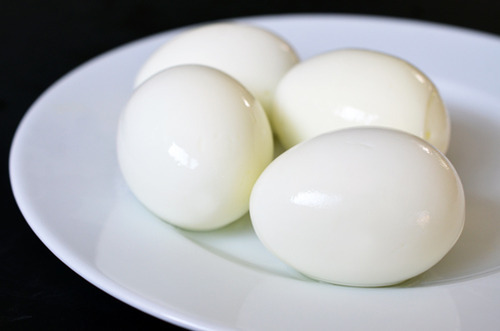
Once the chicken’s done, remove the lid of the Dutch oven and turn the heat up to medium-high.
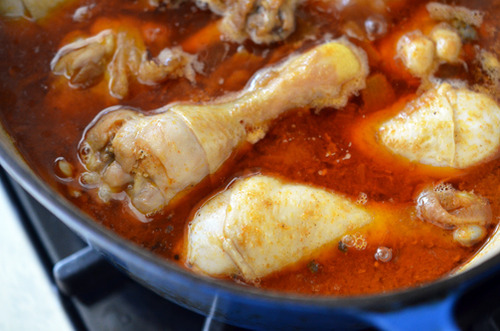
Cook for 5 to 10 minutes until the liquid is reduced by approximately one-third.

If you’re adding lime juice, do it now. The citrusy zing adds a nice, zesty brightness to this long-simmered dish.
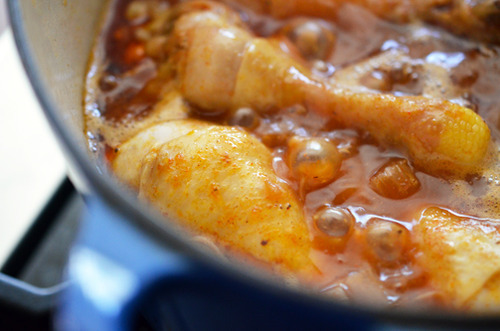
Your kitchen should be smelling pretty awesome right about now.
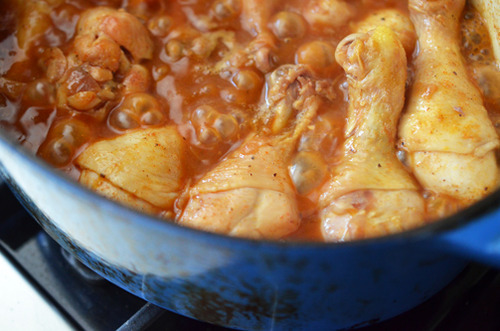
Cut the hard-boiled eggs into wedges.
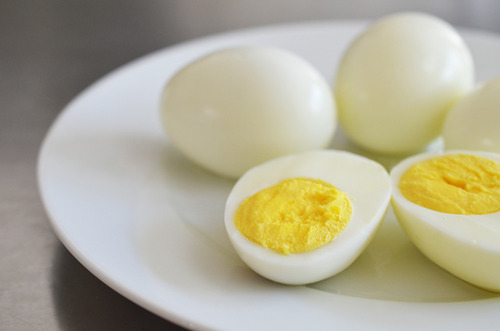
Transfer the chicken drumsticks to a serving platter, garnish with the egg wedges, and ladle the spicy sauce on top.
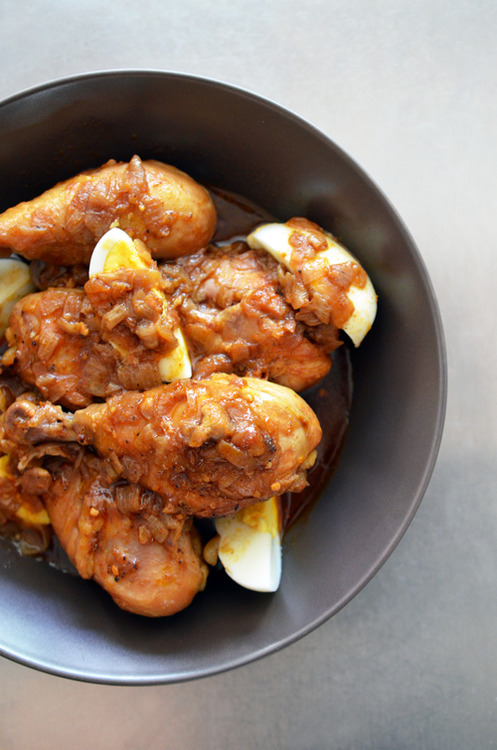
Who says you need a layer of soggy injera bread to eat the stew? Use a FORK.
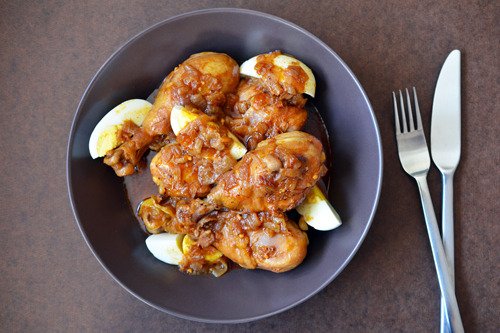
Pro tip: before digging in, make sure you have a nice, tall glass of ice water ready. Depending on your heat tolerance (and the amount of berbere you added to your stew), you may need to call the fire department to put out the blaze in your mouth.

I haven’t been out for an Ethiopian meal in a long time—mostly because the injera bread in most restaurants are made with all-purpose flour instead of just gluten-free teff flour. But after all these years, I still can’t get enough of the hearty, slow-cooked stews of Ethiopia and Eritrea. If you’ve never tried doro wat, give it a shot. I have a feeling you’ll fall head over heels, too.
Looking for a fabulous Whole30-friendly Ethiopian vegetable side dish? Make Akilt, Ethiopian Vegetable Stew!
Looking for more recipe ideas? Head on over to my Recipe Index. You’ll also find exclusive recipes on my iPhone and iPad app, and in my cookbooks, Nom Nom Paleo: Food for Humans (Andrews McMeel Publishing 2013), Ready or Not! (Andrews McMeel Publishing 2017), and Nom Nom Paleo: Let’s Go! (Andrews McMeel Publishing 2021).
PRINTER-FRIENDLY RECIPE CARD
Doro Wat (Spicy Ethiopian Chicken Stew)

Ingredients
- 3 pounds chicken drumsticks skin on or off
- Diamond Crystal kosher salt
- ¼ cup ghee
- 2 medium red onions thinly sliced
- 3 garlic cloves minced
- 1 tablespoon minced ginger
- 1 tablespoon berbere seasoning or more if you like it spicy
- ¼ teaspoon ground cardamom
- ¼ teaspoon Freshly ground black pepper
- 2 cups chicken broth
- 4 hard boiled eggs
- 2 tablespoons freshly squeezed lime juice optional
Instructions
- Thoroughly season the drumsticks with salt, and set aside.
- Heat the ghee in a large Dutch oven over medium heat. Add the sliced onions, and let them cook undisturbed for 1 to 2 minutes. Season liberally with salt, and gently turn over the pile of onions every 3 to 4 minutes to ensure even cooking.
- Once the onions have softened and significantly reduced in volume, about 15 minutes, turn the heat to medium-low.
- Continue cooking, turning over the onion pile every 10 minutes or so, for 30 to 40 minutes or until golden brown and nicely caramelized.
- Stir the garlic and ginger into the caramelized onions, and cook until fragrant, about 30 seconds.
- Add the berbere, cardamom, and black pepper. Cook the spices until fragrant, then, pour in the chicken stock and stir to mix well.
- Nestle the drumsticks into the liquid, and bring the contents of the pot to a low simmer. Cover and cook, turning the drumsticks occasionally, for 45 minutes or until the meat is tender and cooked through.
- Once the chicken’s done, remove the lid of the Dutch oven and turn the heat up to medium-high. Cook for 5 to 10 minutes until the liquid is reduced by approximately one-third.
- If you’re adding lime juice, do it now. The citrusy zing adds a nice, zesty brightness to this long-simmered dish.
- Cut the hard-boiled eggs into wedges. Transfer the chicken drumsticks to a serving platter, garnish with the egg wedges, and ladle the spicy sauce on top.
Notes
Nutrition
Nutrition information is automatically calculated, so should only be used as an approximation.

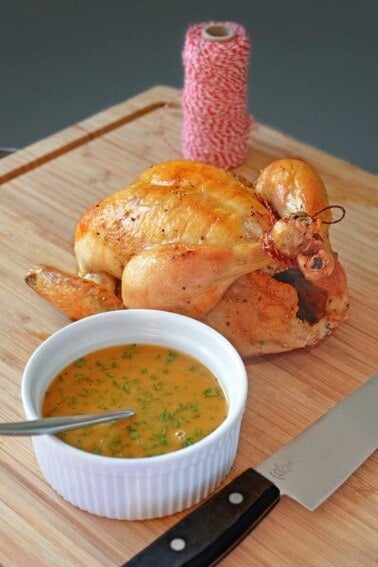
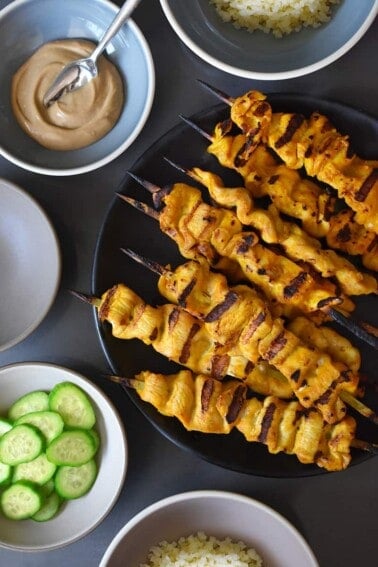

I love Doro Wat and want to make this but I don’t love the texture of drumsticks. Would it work ok with chicken thighs?
It should work!
Absolutely! I prefer thighs because they have more meat. Traditionally, a whole chicken is used. It is cut up into 12 pieces to represent the 12 Apostles.
I made my own niter kibbeh and berbere. 15 minutes seems to be too much on the initial onion cook (for my stove) but do everything else as written. Holy cow, it’s soooo good. I’ve made it 4-5 times the last couple of years and will always use this one!
Do you think this would work with boneless chicken breast? Thanks!
Yes, but the cook time will change and with chicken breast it is less tender.
I’ve tried this recipe many times and loved it! trying it in the slow cooker today as I now have a toddler that won’t allow me to stand at the stove as long lol. Sautéed the onions, garlic, and ginger first though so hopefully it comes out nice! Can I substitute lemon juice for lime? thank you!
Thank you, thank you, thank you for letting everyone know that caramelizing the onions is a slow process and can take quite some time! The deeply browned caramelization is what add such a boost of savory flavor to this stew. Don’t be in a hurry to make this dish. It is a bit time consuming, but Ohhhhhhhh! SO worth it!
I have been making Doro Wat for close to 40-years. I have to say, I don’t know of anyone who uses red onions because they are sweet and better suited in salads or on a sandwich. Use yellow onions instead for a robust flavor.
I also do not put lime juice in my Doro Wat; nor do I know anyone else who does. However, while I am dicing up the onions, I will drizzle lemon juice over the chicken and let it sit until I am ready to add it to the Wat. It helps tenderize the chicken, but it also ‘cleans’ the chicken and adds flavor to the meat.
You can use any parts of the chicken you like. I prefer to use thighs because they have more meat than drumsticks. Traditionally, a while chicken is used. It is cut into 12 pieces to represent the 12 Apostles.
I leave the skin on, as it adds a deeper chicken flavor to the wat. You can remove it before serving if you prefer.
You can serve the chicken pieces whole if you like, or you can shred it off the bone and add it back to the Wat. That assures everyone gets chicken, and it can be easier to scoop up with the injera.
If you can’t get injera from a local Ethiopian restaurant, you can make your own, but it takes about 5 days to make it because it has to ferment. It’s not an necessarily easy task. You can serve Doro Wat over rice, too. That’s not traditional, but it works.
If you are using quality Berbere, there is no need to add cardamom because it is in the spice mix. I don’t add black pepper either.
Speaking of Berbere, know that it’s ‘heat’ is comparable to cayenne pepper because, well, it is made with cayenne peppers. It also includes paprika, red pepper flakes, fenugreek, clove, ginger, turmeric, cardamom, black pepper, cumin, coriander, chili powder, cinnamon, and allspice. I also don’t add ginger to my Wat because it is in the Berbere. Adding extra can upset the balance of a perfectly blended spice.
If you are sensitive to ‘spicy’ foods, start out easy with the Berbere. You can always add more to taste, but once it’s in there, it’s IN there.
You can add a good pinch of salt to taste. Note: Berbere does not contain salt so, be careful when buying it. Some manufacturers will put salt in their spice blend as a ‘filler’. I have made my own Berbere before, but it can get a little pricey buying individual spices; not to mention time consuming. I purchase Frontier Organic Berbere by the pound (it is just $16.00 at Amazon).
I divide it up into smaller packets of 1/4 cup each, vacuum seal them and store them in the freezer. I get about 16 servings (I use 1/4 cup in my recipe, but I like the heat). It lasts a year or longer in the freezer. You can also put the (foil) bag inside a plastic freezer bag and expel as much air as possible, then place that in an airtight container (Tupperware) and you can use as much or as little and you need or want. I add Berbere to my scrambled eggs, and in my dry rubs for chicken, steaks, an other meats. Anywhere you would typically use cayenne pepper – like in your chili!
After you hard boil the eggs, put lengthwise slits in them (not too deep, just through the whites almost to the yolk) and add them to the Wat and let them simmer in the juice to absorb the flavors. The eggs are served whole.
One thing I don’t see in your recipe is T’ej, a rich honey wine. You can find it at most reputable wine and liquor stores, but if you can’t find it, add mead or a good red wine. It adds a touch of sweetness to the pot. The alcohol will cook off as the Wat simmers. If you or a guest is ‘alcohol sensitive’, just leave it out. The chicken stock will more than suffice.
For something a bit different, but just as delicious, make Sega Wat by using stew meat in place of the chicken. Doro means chicken, Sega means beef. Wat means sauce. Of course, you can also use lamb, turkey, venison, or bison.
Any way you make it, take your time, caramel those onions, and enjoy!